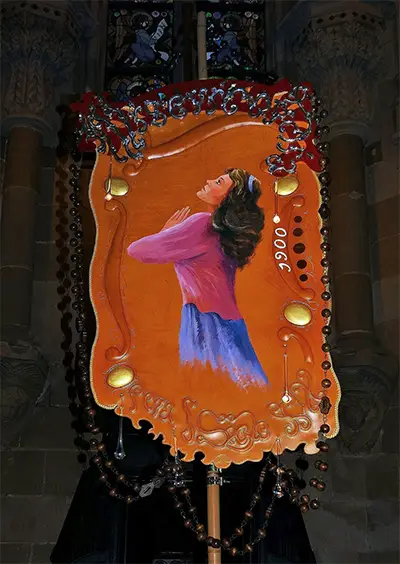The Banner of Misericordia is a drawing by the famous painter and architect, Antoni Gaudi. Antoni painted this piece in 1900 as a projection of the procession of his fellow Reusians living in Barcelona to the sanctuary. The painting was even published in the Reus Catholic Weekly magazine in July 1900.
The magazine also included a picture of the procession in which Antoni is seen as part of a team of pilgrims. In this photograph, the banner is carried by one of the members. The painting stayed in the sanctuary till July 1936 when it was wrecked during the Spanish Civil War. Nevertheless, a project to reconstruct a replica of the picture was carried out between 2003 and 2007. The project was primarily based on an in-depth analysis of the photographs, use of the same techniques, and the same materials as the original portrait. The persons that need to have a glimpse of this famous painting can see it at the crypt of the Sagrada Familia Temple in the City of Barcelona.
Overview of the Drawing
The painting, according to the information published in the July 1900 magazine, comprised of a printed flag as well as a holey leather of roughly trapeze shape in a vertical direction designed by front and back. The very first painting was drawn with the image in a prayer of Isabel Besora, a popular shepherdess at the time. This canvas was done by Aleix Clapes, Antoni's friend who also lived in Reus and worked together with him in painting the Casa Mila and the Palau Guell. The back face contained Barcelona's shield painted in silver and gold in exceptionally stylized form. It also has a rose that symbolized Reus. An image of Mercy, the Virgin of Misericordia, flanked by angels and spread with mantle decorated the bamboo stick with metallic applications of polychrome aluminium.
Over this portrait, there was the name of Jesus and a Cross. Both the front and back of the canvas had writings. The upper front had the words "Misericordia," while the lower part had the words "Per al segle XIX" (translated to English, it means "For the 19th century"). These inscriptions were designed with letters of bossed and carved aluminium and coloured "1900" based on the Holy Year. The words "Barcelona" and "Reus" were painted on the sides of the back face of the painting. These words were painted above the word "Misericordia" and below the phrase "Per a nantrus" (translated to English, it means "For US").
The Materials Used
The entire set was enfolded in a rosary designed with aluminium and bronze beads. Also, the internal structure that attached the flag to the mast and strengthened it was made of aluminium as well. All the materials used in the design of the canvas were extremely light. This enabled the movement of the portrait during the procession. The metal parts were probably designed by the architect’s cousin, Jose Gaudi Pomerol. Jose Gaudi had a workshop in Sant Pere neighbourhood in Barcelona.
What did the portrait Symbolize?
The painting represented the appearance of the Virgin to the shepherdess. This was in 1592 when the Virgin prayed after a severe epidemic attacked the city. According to traditions, the Virgin said that a candle should be lit on the altar of the church. The flame emitted by the candle could end the evil by turning the walls of the city in a procession.




